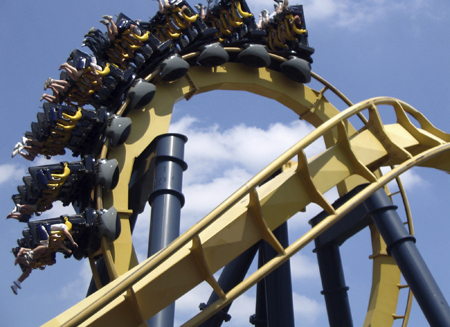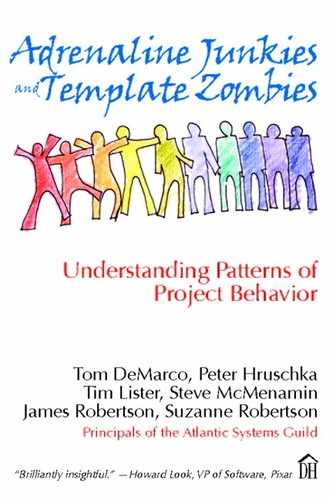1. Adrenaline Junkies
,
The organization believes that frenzied activity is a sign of healthy productivity.
The phone rings.
“We really have to fix a requirements specification this week. Can you come and see what you can do with it?”
“What’s wrong with the specification?”
“We were in a hurry, so we got a bunch of new hires to write it. We think they don’t know what they’re doing.”
“Then wouldn’t it be more productive for us to coach them in writing requirements?”
“But we need the specification this week.”
“Okay, I’ll come tomorrow.”
Two hours later:
“Can you come and look at our estimates?”
“What happened to the specification?”
“We don’t have time. We’ll go ahead with the requirements as they are. My boss wants the estimates to be handed in today. . . .”
You probably recognize the characteristics of the adrenaline junkie organization: Priorities are constantly shifting; everything is needed “yesterday;” there’s never enough project time before delivery; every project is urgent; and the urgent projects just keep coming. Everybody is frantically busy . . . all the time.
People in these organizations do not think strategically. Work gets done on the basis of its urgency alone. Unless a project’s “frantic factor” is high, it will be ignored—even though it promises a significant long-term advantage. It will remain ignored until it suddenly (surprise, surprise) becomes urgent. Adrenaline junkies believe that the best way to work is not by planning but by running as fast as possible.
This kind of culture equates desperate urgency with effective performance. If you are part of such a culture, it is difficult to avoid becoming addicted: Urgency is encouraged. The programmers who work through the night to meet an absurdly short deadline are lionized (never mind the quality of what they deliver). Teams that routinely come in on the weekend, just to keep up with their workload, are regarded more favorably than those that don’t. Moreover, if you’re somebody who does not work excessive overtime and are not frenetically busy all the time, then you are not “one of us”; you are not one of the busy-busy-busy people who keep the organization afloat. Non-heroic activity is plainly not acceptable.
Most adrenaline junkie organizations contain at least one bottleneck. This is the hero who makes all the design decisions, is the only source of requirements, or makes all the architectural decisions. He is playing two roles: One is to make himself appear to be busier than mere mortals can hope to be. The second is to produce a logjam of decision-making that once released, causes the rest of the organization to become even more frantic.
Most adrenaline junkie organizations enthusiastically embrace the customer service ethic: They confuse responding to urgency with admirable responsiveness. When a customer makes a request, regardless of its potential for profit (or even usefulness), it instantly becomes a project, often with a ridiculously short deadline. (See Pattern 38, “Project Sluts,” for more on this.) This new project naturally increases the workload on the already overloaded heroes, so more busyness comes about—all of it feeding the insatiable need for the organization to be very, very busy. Many of these organizations think—falsely—that this is what being agile is all about.
Adrenaline junkie organizations react rather than consider. The result is that most things are in a state of flux, and nothing is settled or long-term. The fluid state persists: Specifications are fluid—nobody really knows what to build. Designs and plans are fluid—they will almost certainly be changed tomorrow. There is no attempt to prioritize by importance or value—there is just urgency.
There is no Betty Ford Clinic for adrenaline junkie organizations, and there may well be no cure short of eliminating the adrenaline junkies and replacing them with managers who understand that the organization is most effective when it is not in a state of emergency. Such a replacement may well be impossible, though: It is usually upper management, and often the CEO, who wants to see the organization in a constant state of frenzy. After all, frenzy sustains the illusion of healthy productivity. And if the managers of a company are adrenaline junkies, then project teams are not far behind.
Adrenaline junkie organizations don’t always fail. Some of them continue to operate at a frenzied pace for years. But none of them can ever build anything big—that requires stability and planning. Junkie behavior is not scalable—it is limited to what can be achieved by a relatively few people working very, very hard with little direction or strategy.
Naturally, in any organization, there are times when things need to be done urgently, and there are some roles in an organization that need to concentrate on urgent tasks. But all things are not always urgent, and all roles are not concerned with urgent matters. Unless urgency can be replaced with prioritization and restraint, there is little hope of curing the addiction to adrenaline.
